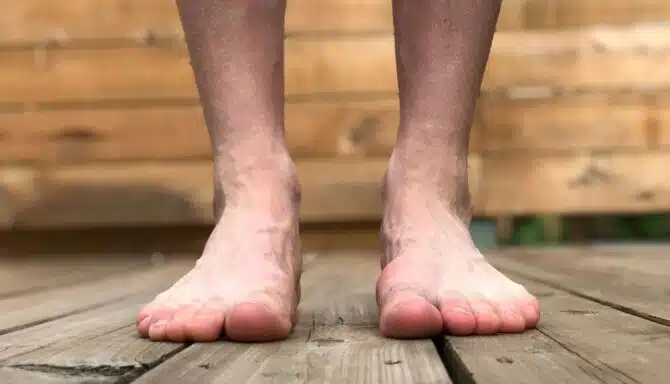Since we discussed common sports injuries to the feet last week, today we’ll focus on one of those injuries – the all-too-familiar ankle sprain. Many of us have been there: We’re going about our day, enjoying our favourite activities, when we take a misstep and feel a sudden onset of pain in our ankle. We then try to put weight on it, but something feels a little off, and we wonder, “Oh no! Did I just sprain my ankle?”
Fortunately, we’re here to let you know the symptoms of an ankle sprain. We’ll also give you the lowdown on what to do if you sprain your ankle, and how to ease your way into rehabilitation.
What is an Ankle Sprain?
The Mayo Clinic describes a sprained ankle as a common injury that occurs when the ligaments that hold your ankle bones together are torn or stretched. Usually, twisting, turning or rolling your ankle clumsily and suddenly can cause an ankle sprain. That being said, the level of pain you will experience and its impact on your mobility depends on how serious the sprain is.
Symptoms of a Sprained Ankle
If you think you sprained your ankle, you should find a space where you can comfortably assess your ankle for symptoms. Preferably with the help of someone else, you can then take the proper steps to make sure you’re on the right path towards recovery.
You should assess your ankle for the following symptoms:
- Ankle popping (you may have heard a popping noise when the sprain occurred)
- Tenderness when you touch your ankle
- Swelling
- Pain in the ankle when trying to put pressure on your foot by walking
If you’re experiencing any of these symptoms, and they occurred immediately after twisting, turning or rolling your ankle, there’s a good chance you may have sprained your ankle.
Have you Sprained your Ankle? Don’t Panic!
There are certain steps you should follow if you think you have sprained your ankle. You should start the treatment process immediately after the sprain. First and foremost, you should not try to walk normally after a sprain, as it can prolong the healing process and aggravate the sprain. (Another sign of an ankle sprain is that you can’t “walk it off”.)
Naturally, you should see your family doctor so they can properly assess you. If you have to wait to see a doctor, you should get home right away and begin treating yourself. If you can, try to walk as little as possible when getting home.
Treating a newly sprained ankle with at-home foot care typically involves:
- Resting
- Elevating your sprained ankle
- Using an ice pack for compression
When you see your doctor, they may do a combination of the following:
- Physically examine your ankle
- Request MRI or X-ray imaging of the sprain
- Suggest crutches if the sprain is severe
Rehab for your Sprained Ankle
When it comes to sprains, rehabilitation is just as important as the initial treatment plan. Once your ankle starts to heal, you can start looking into ways to get moving again. You should do this carefully and thoughtfully so your ankle heals fully and doesn’t lead to other injuries.
Chiropodists are trained to understand the ankle region and can provide you with the following services and advice on how to gradually ease back into physical activity:
- Foot Exercises: Regularly stretching and exercising the affected ankle can work wonders during the recovery phase. They are designed to help you improve your range of motion, strengthen the sprained ligaments, and help you regain balance and control. Exercising everything from your toes to your heels and, of course, your ankle will keep you on the right track to a full recovery. Here are some exercises that we suggest! You can also check out our Pinterest page for additional lower body exercises.
- Custom orthotics: Orthotics have been known to reduce ankle pain in those recovering from a recent injury. Not only that, but they have also been proven to help with ankle instability for those with a history of ankle sprains. They do this by correcting biomechanical irregularities, reducing injury compensation, and helping to support your ankle while it heels. A foot specialist can assess you for a pair of orthotics that is perfectly tailored to your needs. Be sure to check out our Complete Guide to Custom Orthotics for more information.
- Compression stockings: These are a great way to apply continued compression to your ankle while still letting you be mobile. You can also wear compression stockings in bed when you need to rest during the recovery process. Foot care experts recommend compression stockings for keeping the swelling down. Compression therapy also improves blood circulation, which stimulates your body’s natural healing process. You can get a pair where the compression is focused on your ankle and gradually reduces further up your leg. You may also opt for an ankle compression sleeve that just covers the ankle.
- Ankle Bracing and Taping: Bracing and taping the ankle helps to demobilize, support and stabilize the muscles and ligaments while they heal. This reduces the risk of further injury.
Need More Foot Care Info?
We’re confident in our ability to help inform you and solve your concern with the least amount of discomfort possible. If you have a quick question, call our downtown foot clinic and we’d be happy to point you in the right direction. Our Toronto foot specialists are on hand 6 days a week and are eager to help you!
Call us at 416-769-FEET (3338) or Book Your Assessment Today!












